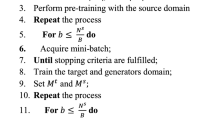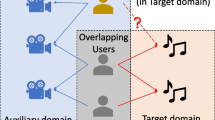Abstract
Entity linking is a new technique in recommender systems to link users’ interaction behaviors in different domains, for the purpose of improving the performance of the recommendation task. Linking-based cross-domain recommendation aims to alleviate the data sparse problem by utilizing the domain-sharable knowledge from auxiliary domains. However, existing methods fail to prevent domain-specific features to be transferred, resulting in suboptimal results. In this paper, we aim to address this issue by proposing an adversarial transfer learning based model ATLRec, which effectively captures domain-sharable features for cross-domain recommendation. In ATLRec, we leverage adversarial learning to generate representations of user-item interactions in both the source and the target domains, such that the discriminator cannot identify which domain they belong to, for the purpose of obtaining domain-sharable features. Meanwhile each domain learns its domain-specific features by a private feature extractor. The recommendation of each domain considers both domain-specific and domain-sharable features. We further adopt an attention mechanism to learn item latent factors of both domains by utilizing the shared users with interaction history, so that the representations of all items can be learned sufficiently in a shared space, even when few or even no items are shared by different domains. By this method, we can represent all items from the source and the target domains in a shared space, for the purpose of better linking items in different domains and capturing cross-domain item-item relatedness to facilitate the learning of domain-sharable knowledge. The proposed model is evaluated on various real-world datasets and demonstrated to outperform several state-of-the-art single-domain and cross-domain recommendation methods in terms of recommendation accuracy.
Similar content being viewed by others
References
Srivastava R, Palshikar G K, Chaurasia S, Dixit A M. What’s next? A recommendation system for industrial training. Data Science and Engineering, 2018, 3(3): 232-247.
Zhao P, Zhu H, Liu Y, Xu J, Li Z, Zhuang F, Sheng V S, Zhou X. Where to go next: A spatio-temporal gated network for next POI recommendation. In Proc. the 33rd AAAI Int. Conf. Artificial Intelligence, January 2019, pp.5877-5884.
Li B, Yang Q, Xue X. Can movies and books collaborate? Cross-domain collaborative filtering for sparsity reduction. In Proc. the 21st Int. Joint Conf. Artificial Intelligence, July 2009, pp.2052-2057.
Cantador I, Fernández-Tobías I, Berkovsky S, Cremonesi P. Cross-domain recommender systems. In Recommender Systems Handbook, Ricci F, Rokach L, Shapira B (eds.), Springer, 2015, pp.919-959.
Liu J, Zhao P, Zhuang F, Liu Y, Sheng V S, Xu J, Zhou X, Xiong H. Exploiting aesthetic preference in deep cross networks for cross-domain recommendation. In Proc. the 29th World Wide Web Conference, April 2020, pp.2768-2774.
Berkovsky S, Kuik T, Ricci F. Mediation of user models for enhanced personalization in recommender systems. User Model. User-Adapt. Interact., 2008, 18(3): 245-286.
Fernández-Tobías I, Cantador I. Exploiting social tags in matrix factorization models for cross-domain collaborative filtering. In Proc. the 1st Workshop on New Trends in Content-based Recommender Systems Co-Located with the 8th ACM Conf. Recommender Systems, October 2014, pp.34-41.
Tan S, Bu J, Qin X, Chen C, Cai D. Cross domain recommendation based on multi-type media fusion. Neurocomputing, 2014, 127: 124-134.
Man T, Shen H, Jin X, Cheng X. Cross-domain recommendation: An embedding and mapping approach. In Proc. the 26th Int. Joint Conf. Artificial Intelligence, August 2017, pp.2464-2470.
Zhu F, Wang Y, Chen C, Liu G, Orgun M A, Wu J. A deep framework for cross-domain and cross-system recommendations. In Proc. the 27th Int. Joint Conf. Artificial Intelligence, July 2018, pp.3711-3717.
Yang Q, Hu G, Zhang Y. CoNet: Collaborative cross networks for cross-domain recommendation. In Proc. the 27th ACM Int. Conf. Information and Knowledge Management, October 2018, pp.667-676.
Huang L, Zhao Z L, Wang C D, Huang D, Chao H Y. LSCD: Low-rank and sparse cross-domain recommendation. Neurocomputing, 2019, 366: 86-96.
Loni B, Shi Y, Larson M A, Hanjalic A. Cross-domain collaborative filtering with factorization machines. In Proc. the 36th European Conf. Information Retrieval Research, April 2014, pp.656-661.
Zhang F, Yuan N J, Lian D, Xie X, Ma W Y. Collaborative knowledge base embedding for recommender systems. In Proc. the 22nd ACM SIGKDD Int. Conf. Knowledge Discovery and Data Mining, August 2016, pp.353-362.
Wang W, Yin H, Du X, Hua W, Li Y, Nguyen Q V H. Online user representation learning across heterogeneous social networks. In Proc. the 42nd ACM SIGIR Int. Conf. Research and Development in Information Retrieval, July 2019, pp.545-554.
Ma J, Wen J, Zhong M, Chen W, Li X. MMM: Multi-source multi-net micro-video recommendation with clustered hidden item representation learning. Data Science and Engineering, 2019, 4(3): 240-253.
Tan C, Sun F, Kong T, Zhang W, Yang C, Liu C. A survey on deep transfer learning. In Proc. the 27th Int. Conf. Artificial Neural Networks, October 2018, pp.270-279.
Goodfellow I J, Pouget-Abadie J, Mirza M, Xu B, Warde-Farley D, Ozair S, Courville A C, Bengio Y. Generative adversarial nets. In Proc. the 2014 Annual Conf. Neural Information Processing Systems, December 2014, pp.2672-2680.
Yuan F, Yao L, Benatallah B. DARec: Deep domain adaptation for cross-domain recommendation via transferring rating patterns. In Proc. the 28th Int. Joint Conf. Artificial Intelligence, August 2019, pp.4227-4233.
Wang C, Niepert M, Li H. RecSys-DAN: Discriminative adversarial networks for cross-domain recommender systems. IEEE Transactions on Neural Networks and Learning Systems. https://doi.org/10.1109/TNNLS.2019.2907430.
Kanagawa H, Kobayashi H, Shimizu N, Tagami Y, Suzuki T. Cross-domain recommendation via deep domain adaptation. In Proc. the 41st European Conf. Information Retrieval, April 2019, pp.20-29.
He X, Liao L, Zhang H, Nie L, Hu X, Chua T S. Neural collaborative filtering. In Proc. the 26th Int. Conf. World Wide Web, April 2017, pp.173-182.
Berkovsky S, Kuik T, Ricci F. Cross-domain mediation in collaborative filtering. In Proc. the 11th Int. Conf. User Modeling, June 2007, pp.355-359.
Singh A P, Gordon G J. Relational learning via collective matrix factorization. In Proc. the 14th ACM SIGKDD Int. Conf. Knowledge Discovery and Data Mining, August 2008, pp.650-658.
Denton E L, Chintala S, Szlam A, Fergus R. Deep generative image models using a Laplacian pyramid of adversarial networks. In Proc. the 2015 Annual Conf. Neural Information Processing Systems, December 2015, pp.1486-1494.
Zhang Y, Barzilay R, Jaakkola T S. Aspect-augmented adversarial networks for domain adaptation. Transactions of the Association for Computational Linguistics, 2017, 5: 515-528.
Gui T, Zhang Q, Huang H, Peng M, Huang X. Part-of-speech tagging for twitter with adversarial neural networks. In Proc. the 2017 Conf. Empirical Methods in Natural Language Processing, September 2017, pp.2411-2420.
Xu C, Zhao P, Liu Y, Sheng V S, Xu J, Zhuang F, Fang J, Zhou X. Graph contextualized self-attention network for session-based recommendation. In Proc. the 28th Int. Joint Conf. Artificial Intelligence, August 2019, pp.3940-3946.
Zhang T, Zhao P, Liu Y, Sheng V S, Xu J, Wang D, Liu G, Zhou X. Feature-level deeper self-attention network for sequential recommendation. In Proc. the 28th Int. Joint Conf. Artificial Intelligence, August 2019, pp.4320-4326.
Chen J, Zhang H, He X, Nie L, Liu W, Chua T S. Attentive collaborative filtering: Multimedia recommendation with item- and component-level attention. In Proc. the 40th ACM SIGIR Int. Conf. Research and Development in Information Retrieval, August 2017, pp.335-344.
Cheng Z, Ding Y, He X, Zhu L, Song X, Kankanhalli M S. A3NCF: An adaptive aspect attention model for rating prediction. In Proc. the 27th Int. Joint Conf. Artificial Intelligence, July 2018, pp.3748-3754.
Shi S, Zhang M, Liu Y, Ma S. Attention-based adaptive model to unify warm and cold starts recommendation. In Proc. the 27th ACM Int. Conf. Information and Knowledge Management, October 2018, pp.127-136.
Xi W D, Huang L, Wang C D, Zheng Y Y, Lai J. B-PAM: Recommendation based on BP neural network with attention mechanism. In Proc. the 28th Int. Joint Conf. Artificial Intelligence, August 2019, pp.3905-3911.
Hu Y, Koren Y, Volinsky C. Collaborative filtering for implicit feedback datasets. In Proc. the 8th IEEE Int. Conf. Data Mining, December 2008, pp.263-272.
Pan R, Zhou Y, Cao B, Liu N N, Lukose R M, Scholz M, Yang Q. One-class collaborative filtering. In Proc. the 8th IEEE Int. Conf. Data Mining, December 2008, pp.502-511.
Ganin Y, Lempitsky V S. Unsupervised domain adaptation by backpropagation. In Proc. the 32nd Int. Conf. Machine Learning, July 2015, pp.1180-1189.
He R, McAuley J J. Ups and downs: Modeling the visual evolution of fashion trends with one-class collaborative filtering. In Proc. the 25th Int. Conf. World Wide Web, April 2016, pp.507-517.
Rendle S, Freudenthaler C, Gantner Z, Schmidt-Thieme L. BPR: Bayesian personalized ranking from implicit feedback. In Proc. the 25th Conf. Uncertainty in Artificial Intelligence, June 2009, pp.452-461.
Misra I, Shrivastava A, Gupta A, Hebert M. Cross-stitch networks for multi-task learning. In Proc. the 2016 IEEE Conf. Computer Vision and Pattern Recognition, June 2016, pp.3994-4003.
Author information
Authors and Affiliations
Corresponding author
Electronic supplementary material
ESM 1
(PDF 601 kb)
Rights and permissions
About this article
Cite this article
Li, Y., Xu, JJ., Zhao, PP. et al. ATLRec: An Attentional Adversarial Transfer Learning Network for Cross-Domain Recommendation. J. Comput. Sci. Technol. 35, 794–808 (2020). https://doi.org/10.1007/s11390-020-0314-8
Received:
Revised:
Published:
Issue Date:
DOI: https://doi.org/10.1007/s11390-020-0314-8




